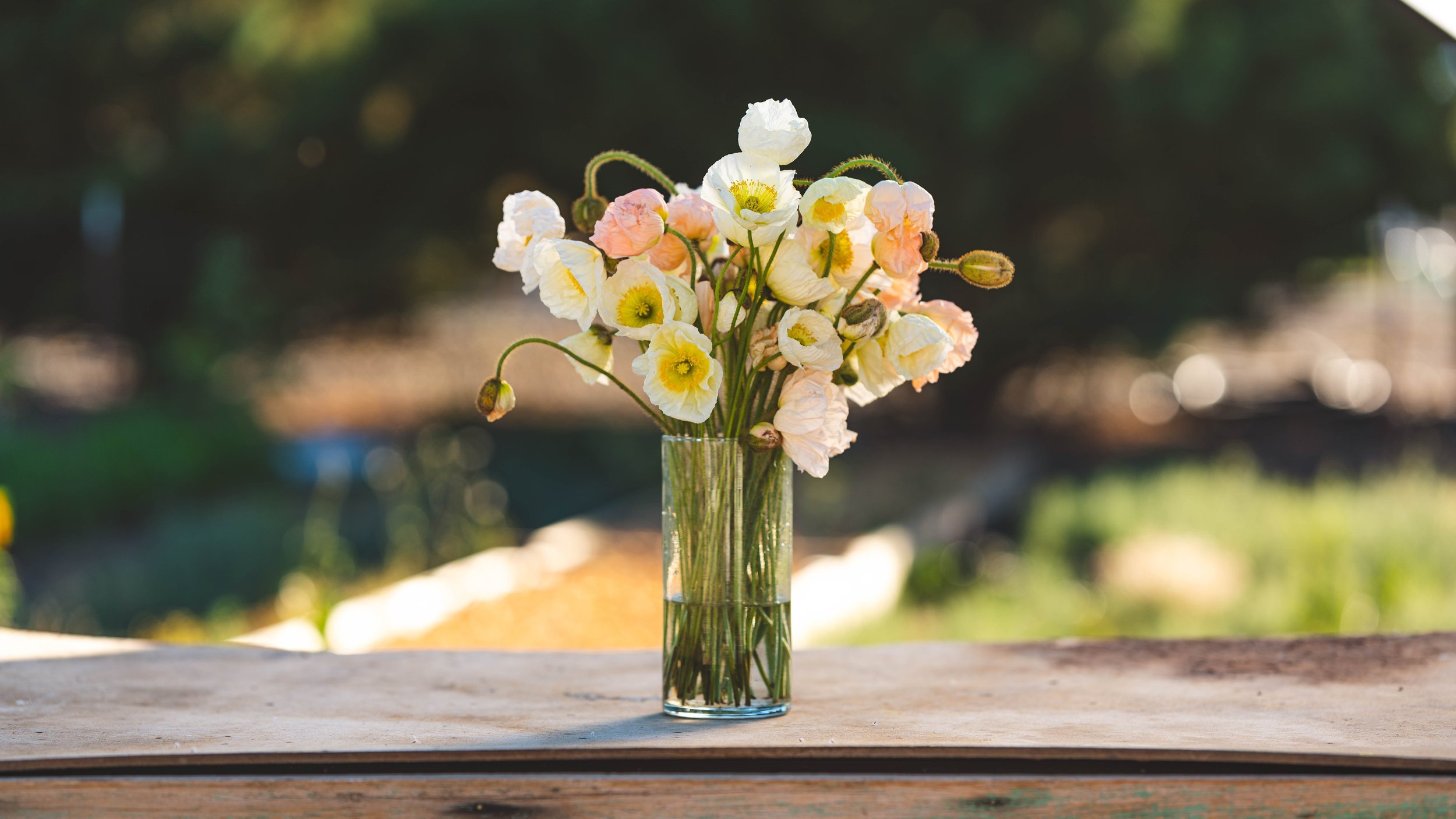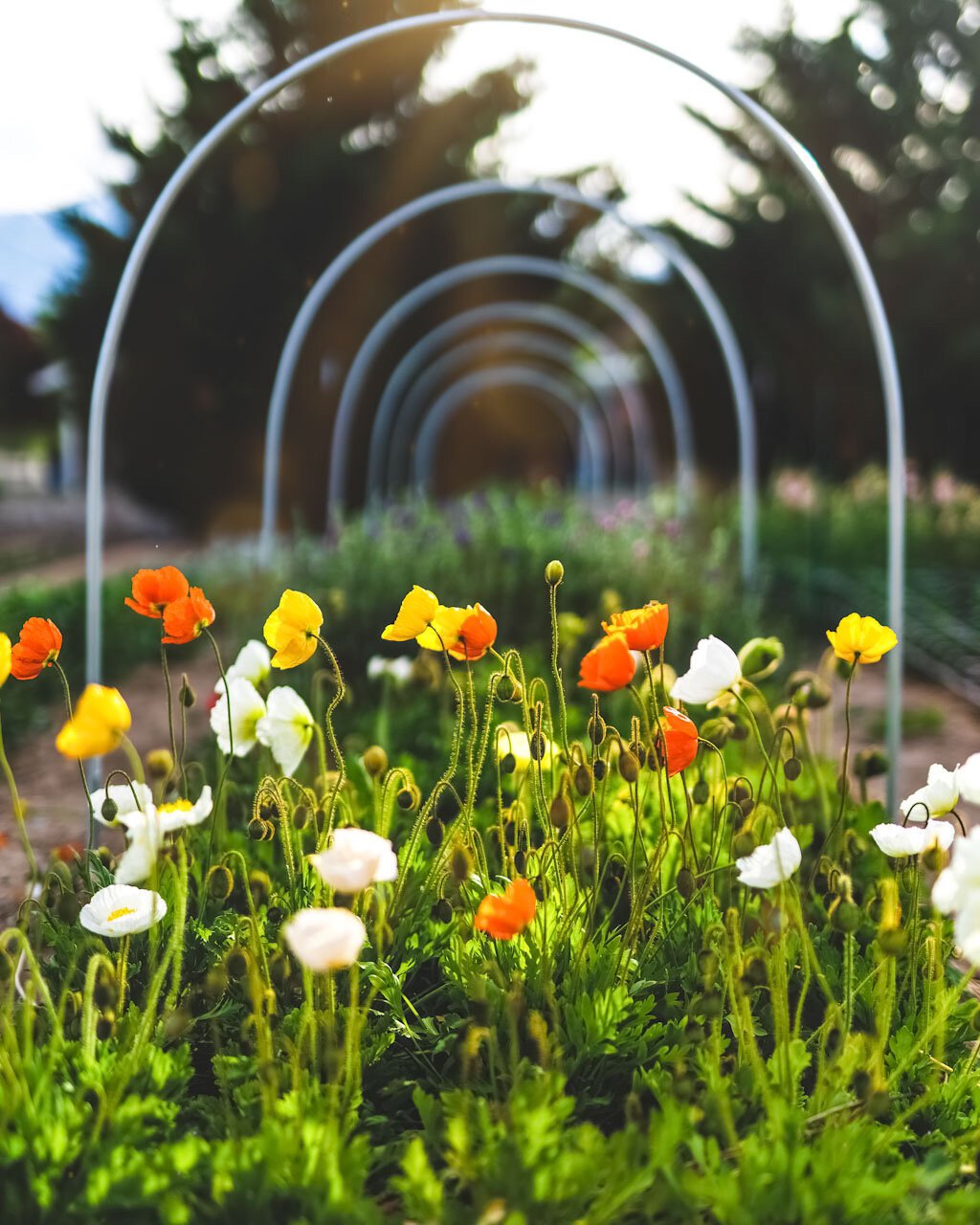Growing Iceland Poppies: A Delicate Cut Flower with a Bold Impact
Poppies have held a special place in my heart since childhood. I remember the thrill of spotting a California poppy growing defiantly in a crack of cement, only to learn it was off-limits to pick. Now, as a flower farmer in Nevada, I laugh at the irony of cherishing such a “weed” and watching my children pick them with glee.
Among the many types of poppies, Iceland poppies (Papaver nudicaule) stand out as a flower farmer’s dream. Their delicate, tissue-like petals and vibrant ice cream parlor colors bring charm to the garden and bouquets alike. Unlike most poppies, Iceland poppies boast an impressive vase life, making them a perfect choice for cut flower growers.
In this guide, I'll share everything you need to know to grow, harvest, and design with these enchanting blooms. Whether you're a backyard gardener or a small-scale flower farmer, Iceland poppies can bring delight to your garden, bouquets, and even pollinators.
Note: This post contains affiliate links. If you make a purchase through these links, I may earn a small commission at no additional cost to you. Thank you for supporting our farm!
Colibri Iceland poppies in soft pastel hues, adding delicate beauty to any arrangement.
Growing Iceland Poppies
Growing Iceland poppies might seem intimidating at first, but they’re surprisingly resilient and less demanding than they appear. Once you understand their needs, they’ll reward you with months of prolific blooms.
Seed Starting Tips:
Iceland poppy seeds are tiny and typically have about a 70% germination rate. Their small size makes it easy to sow too many into a single cell, so aim for precision to avoid overcrowding.
For precision, use a bamboo skewer or sharp pencil to place 1–2 seeds per cell.
Start seeds in 128-cell trays and transplant to 72-cell trays after 3–4 weeks. Soil blocking with 3/4-inch blocks is another great option.
I use Bootstrap Farmer’s 128-cell and 72-cell trays because they’re durable, long-lasting, and perfect for poppies and other delicate seedlings.
Key Tips for Success:
Don’t bury the seeds: Iceland poppies need light to germinate. Mist seeds into place and lightly dust with vermiculite.
Use a heating mat: A mat set to 70°F speeds up germination to just a few days.
Cold tolerance: These poppies thrive in cool temperatures, making late fall or early winter sowing ideal.
Succession Planting for Continuous Blooms
To maximize your Iceland poppy harvest, consider succession planting. Start with a fall sowing, then follow up with two additional plantings spaced four weeks apart during winter. This staggered approach ensures a steady supply of blooms from late spring into early summer, even as temperatures begin to rise.
Want to learn more about succession planting? Explore our Advanced Succession Planting Guide to map out your planting schedule and get the most out of your garden all season long!
Want to master seed starting? Check out our Seed Starting Guide for expert tips and tricks to get your flowers off to a strong start. Whether you’re new to gardening or an experienced grower, this guide is packed with actionable advice to make your seed starting a success!
Confident in Seed Starting but not sure when to start Iceland Poppies? Read our guide When to Plant: Frost Dates, Soil Temps, and Timing.
Iceland poppies starting strong—this plant is ready to deliver stunning blooms.
Planting and Care
Once established, Iceland poppies are remarkably fuss-free. Here’s how to set them up for success in the garden:
Planting:
Space plants 6–9 inches apart. For tighter rows in small spaces, 6 inches works well, but give more room (up to 9 inches) if airflow is a concern in humid areas.
Soil Prep: Iceland poppies prefer neutral to slightly alkaline soil (pH 6.5–7.5). Before planting, amend the soil with compost or organic matter to improve drainage and fertility, especially in heavier soils.
Watering:
While Iceland poppies aren’t heavy drinkers, they prefer consistent moisture. Water deeply and less frequently to encourage strong root growth. Avoid letting the soil stay soggy, as this can lead to root rot.
Pro-tip: Set up drip tape on automation for consistent watering and healthier plants—plus, it’ll save your sanity!
Tunnel Protection:
In colder climates (like zone 6b), low tunnels with frost cloth are enough for late winter or early spring plantings. For fall planting, consider double tunnels to withstand snow and wind.
Ensure good airflow in tunnels, especially during warm days, to prevent fungal issues. Ventilate as needed to keep the microclimate ideal.
Curious about extending your growing season? Check out our Season Extension Guide for tips on using low tunnels, frost cloth, and more to protect your crops and maximize your harvest.
Fertilizing:
Iceland poppies are light feeders but still benefit from regular nutrients. We typically use fish emulsion and kelp, compost tea, or a liquid fertilizer like FoxFarm Grow Big (for vegetative growth) and Tiger Bloom (to support flowering).
Apply sparingly once plants are established, and be cautious not to over-fertilize, as it can lead to excessive foliage at the expense of blooms.
Common Challenges:
Pests: Thrips, caterpillars, and earwigs can damage blooms. Start treatments early with spinosad or pyrethrins and encourage beneficial insects like lacewings and ladybugs. Sticky traps can also help monitor pest levels.
Disease: Overwatering or poor airflow can lead to fungal issues like botrytis. Regularly inspect plants and remove any infected leaves or stems to prevent the spread.
Heat Sensitivity: Iceland poppies prefer daytime temperatures in the 70s and cool nights. Prolong blooms by providing shade during hot spells and ensuring evening temperatures stay below 60°F. Mulching can help regulate soil temperature in hotter climates.
Maintenance:
Regular deadheading is essential to encourage continuous blooming. Removing spent flowers prevents the plant from putting energy into seed production and keeps your garden tidy, preventing potential disease and pests.
Harvesting flowers early in the morning or evening can double as deadheading while ensuring you get the freshest blooms.
New to transplanting delicate seedlings? Check out our Transplanting Seedlings Guide for step-by-step instructions to minimize transplant shock and set your young plants up for success!
Iceland poppies in the growing patch, thriving under low tunnels in a vibrant mix of Bubbles series blooms.
Iceland Poppies as Cut Flowers
Iceland poppies are a favorite among florists and customers for their delicate beauty and surprising durability as cut flowers. Here’s how to maximize their vase life:
Harvesting Tips:
Harvest at the “cracking stage,” when a sliver of color peeks through the bud. This stage not only extends vase life but also helps prevent damage to the delicate petals during handling and transport.
For event work, blooms that have just opened can still offer decent vase life if handled quickly.
Harvest twice daily during peak bloom to stay ahead of their fast-opening flowers.
Post-Harvest Care:
Immediately place stems in sanitized buckets with a CVBN tablet to minimize bacteria growth.
Optional: Sear stem ends with a blowtorch or dip in hot water to reduce latex sap leakage, especially in warmer weather.
Store in a cooler at 38°F for 12–24 hours before arranging.
Iceland poppies can also be dry-stored in the cooler. Harvest at the cracking stage, place dry stems in a sanitized bucket or upright container, and store at 38°F for up to 24 hours. Rehydrate in freshwater before arranging.
Using commercial flower food can further extend vase life and keep blooms looking fresh.
With proper care, Iceland poppies can last up to a week in the vase, far outlasting many other poppy varieties.
A dreamy June bridal bouquet featuring fresh-from-the-field blooms, including Colibri Iceland poppies and other seasonal favorites. Photo Credit: Elsa Boscarello Photography
Designing with Iceland Poppies
The ethereal quality of Iceland poppies makes them a stunning addition to any design. Their ruffled, tissue-paper petals add movement and airiness to bouquets, centerpieces, and large installations. Iceland poppies bring a delicate quality to arrangements, making them perfect for whimsical or wildflower-inspired designs.
Handle with Care:
Their delicate, paper-like petals require gentle handling to avoid damage. Despite their fragile appearance, Iceland poppies can last up to a week in the vase with proper care, far outlasting many other poppy varieties.
To fully open blooms harvested at the cracking stage, gently peel back the outer shell to reveal the petals. Placing peeled stems in warm water encourages faster opening.
Iceland poppies perform best in arrangements where they have direct access to water, such as bouquets in vases or centerpieces. Avoid using them in wearables or large installations exposed to direct sun, as they tend to wilt quickly in these conditions.
Care for Bridal Bouquets:
When using Iceland poppies in bridal bouquets, provide a small vessel with water for the bouquet to rest in between photo sessions and use. This helps preserve their freshness and prevents wilting.
Environmental Considerations:
Keep arrangements featuring Iceland poppies in cooler environments, away from direct sunlight, drafts, or heat sources to preserve their delicate blooms.
Varieties We Love:
Champagne Bubbles: Heavy producers with a wide range of soft colors, perfect for adding lightness to designs.
Colibri: Slightly fewer stems but larger, show-stopping blooms that make ideal focal flowers.
Color Pairing Tips:
Iceland poppies pair beautifully with soft pastels like lisianthus, ranunculus, and snapdragons, as well as more vibrant accents like cosmos or sweet peas. Their versatility allows them to shine in both muted and bold palettes.
In our Lake Tahoe weddings, Iceland poppies seamlessly enhance the "wildflower aesthetic" couples often request, paying homage to the natural beauty of the surrounding meadows. Their versatility makes them a favorite for both casual and formal designs, adding a touch of elegance and charm wherever they’re used.
A colorful harvest of Iceland poppies from the Bubbles series, waiting to brighten up designs and bouquets.
Why Iceland Poppies Deserve a Place in Your Garden
Iceland poppies are a cut flower grower’s hidden gem. They bring charm to the garden, joy to pollinators, and magic to every bouquet they grace. While they require a little planning and care, their beauty and flexibility make them well worth the effort. Whether you’re growing them for personal enjoyment or as a unique offering for your flower farm, Iceland poppies are sure to captivate everyone who encounters them.
Explore More Poppy Varieties! Want to grow other types of poppies? Dive into our in-depth guide on poppies, including tips for breadseed, Shirley, and California poppies, in our blog over at Bootstrap Farmer: Poppy Cultivation for Flower Farmers.
Watch Iceland Poppies in Action: Don’t miss our Five-Minute Flower Friday video featuring Iceland poppies! Learn even more tips and tricks for growing, harvesting, and designing with these stunning blooms.
We are looking forward to sharing more blooms with you soon.
Jessica & Graham






